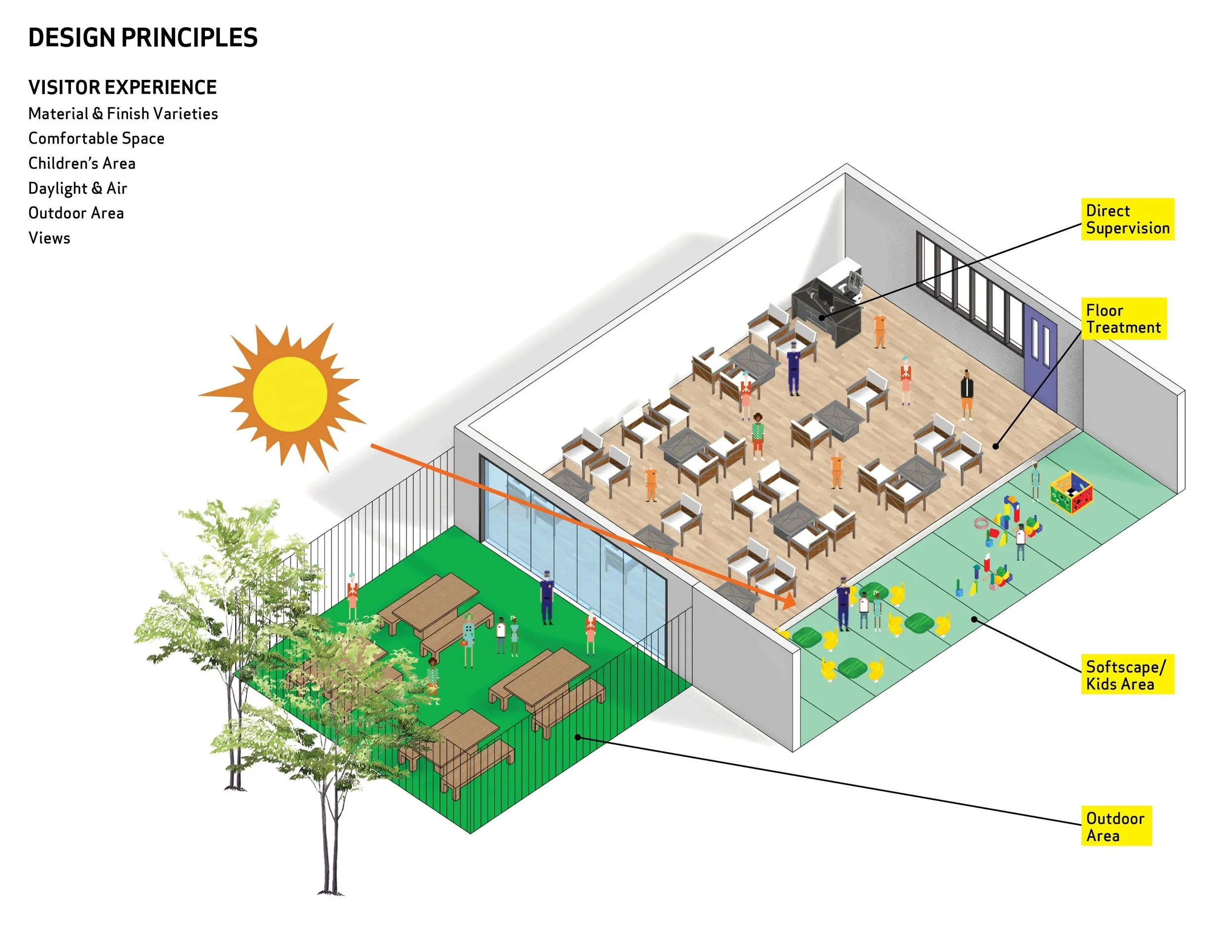Re-Think, Re-Adjust & Re-Design Justice
By Dominique Cuoco
At roughly 2.3 million people, America’s Criminal Justice System (CJS) holds a comparable number of inmates to the whole populations of Houston, Texas, and Brisbane, Australia. In fact, the United States “locks up more people, per capita, than any other nation.”(1) Although we expect cities to grow in the coming decades and are planning for this, it is my hope that America’s criminal justice population decreases and that the quality of life behind bars improves significantly, especially as we take steps to better plan for it.(2)
Instead of living in neighborhoods, inmates are both temporary and permanent residents in over 1,700 state prisons, 100 federal prisons, 3,100 local jails, 900 juvenile correctional facilities - not to mention, military prisons and immigration detention centers spread out across the nation, in utilitarian facilities. (3)
About one third of inmates are in jail rather than prison, regardless of the reason for arrest. (4) Around 75% are held for nonviolent offenses, including property, drug, public order, and traffic violations, (read: parking tickets!). (5) There are compelling disparities to mention here: Black Americans are jailed at almost four times the rate as white Americans. (6) The majority of jail inmates are considered to be “pretrial detainees” because they are awaiting a trial, and were unable to get out of jail within 48-72 hours because they did not, or could not afford to post bail. (7,8)
If a person cannot post bail, they could wait up to 5 years before a trial. Ultimately, 70% of pretrial detainees are found to not be convicted of the crime.The sheer number of this population is “larger than most other countries’ total incarcerated population.”(9) Justice advocacy groups rightfully argue that this is a misuse of jails, time, money, and vastly impacts the opportunities and freedoms of this population based on an unjust practice. Prison Policy Institute raises the question if it is logical to “arrest millions of poor people each year for minor offenses, make them post money bail, and then lock them up when they can’t afford to pay it?” (10) Is it morally sufficient to let anyone walk from a cell because they have the money to do so? Further, looking to keep a criminal justice facility open and fill empty inmate beds for purely economic reasons (job security) is questionable: “we hate to see this facility [Sante Fe] close,” “we’re reaching out to anybody that can help us.” (11) Yikes!
Vera Institute of Justice (14)
There is no replacement for lost time. (12) In 2010, a teenage boy who was wrongly arrested for murder in New York waited in Rikers Island for 3 years as a pretrial detainee, missing key moments in his formative years waiting to be declared innocent. (13)
In New York City alone, 85% of inmates on Rikers Island are pre-trial detainees, 40% of whom have mental health needs. (15) Rikers has a reputation for “exceptional” violence, ultimately causing its closure and re-design. From drug-and gang- involved inmates in the 1980s and 90s, to populations with severe mental illnesses in the 2000s. (16) Even if a person goes to jail as innocent, they would undoubtedly leave learning new behaviors, after having been exposed to an enormous amount of violence. (17)
New York City’s governmental administrations have altered approaches in recent years regarding what is worthy of arrest (low level offenses), lowering bail costs (to decrease the number of pre-trial detainees), and screening and briefing initiatives for those with mental and substance use needs. This will hopefully continue to inspire other cities to adapt similar progressive practices. (18,19) Since the tides changed in 2013, New York City has seen a decrease in jail population by 18%. (20)
More and more has been re-thought to address quality of life during time in jail, and time incarcerated (i.e. after a person has been convicted of a crime).
Living shouldn’t stop in jail, or in prison. The Scandinavian “open” prison design concept is a particularly fascinating model, one in which journalist, Doran Larson, found the prison grounds virtually unrecognizable because “it resembled a quaint, dorm-like community”. (21) Inmates walk around freely in their own clothes, commuting into town to work to afford luxuries like TVs and mini-fridges on the grounds, and can spend time with their families nearby. There’s even a gym on site!
Wardens don’t carry equipment (tasers, pepper-spray, batons), and instead walk around comfortably, happily, suffering less damage and job-related crises than American officers, “who have an average life expectancy of 59.” (22) Further, prisons in Denmark, Sweden, Finland and Norway all include a substantial level of rehabilitative programming, where exciting activities are included in common spaces, and feature prisoner art on the soothing painted walls. Most importantly, officers take a concerted approach to balance security and rehab needs. (23) Danish prisons break the mold of solitary confinement by allowing married couples with children under 3 to live together and allowing inmates to cook their own meals. (24)
While the Scandinavian open prison only contains 95 inmates within a gated area, (a utopian esque figure to the harsh U.S. numbers), the ‘prison factor’ lies in not being able to live the life that the inmate wanted. Living elsewhere from loved ones, living with just yourself and the weight you carry. There is “existential weight” due to the fact that life inside resembles outside however, the true punishment is the “restriction of liberty; no other rights have been removed.” (25) This creates a different experience, which makes it easier for the inmate to return to freedom, somehow intrinsically changed, unaffected by the “bitterness evoked by a system that sustains such an environment.” (26)
You may be wondering - What impacts do open prisons really have, especially on serious incidents like suicides, re-arrests & re-incarceration rates? Well, here were only “three suicides and five other deaths throughout the Danish prison system in 2013, as compared to 4,446 deaths in U.S. jail and state prison facilities that same year” – where suicide is the leading cause of death in local jails since 2000. (27,28) Recidivism rates are at 27% in Denmark, whereas the U.S. rate is 52%. (29)
Could such a model be scalable in the U.S. – should we even try? That’s not necessarily the question.
Should we re-think criminal justice facility re-design & programming to fit a greater purpose – of rehabilitation & connection to services and resources rather than inhumane punishment, and of self-reflection and individual development rather than an existence of survival?
If yes – then how?
From a programming perspective, organizations across the nation are partnering with prisons and jails to increase efforts towards these principles – from educational & job training, to supportive health care, access to technology & hands-on arts, and increased time with loved ones. These are all integral to a person’s growth, inside & outside the criminal justice system, and are already reducing recidivism rates and increasing hope for inmates. (30,31)
Revisiting re-design, New York City is also fast embracing change. De Blasio has committed to dismantling Rikers Island and spreading facilities into Justice Hubs, or safer, healthier,and more effective jails. (32) Todd Brown, architect and environmental psychologist, says that the “best practices in jail design are the same as in any space designed to be humane: natural light, communal areas and green space.” (33) Through collaborative, workshopped efforts, jail design can be thoughtful and imaginative, and prioritize health, openness and connectivity. (34)
Justice in Design model
There is not one single initiative that can address how planners can improve jail and prison life. However, we can reexamine the status quo, we can strategize, set priorities for wellbeing and humanity, and partner with various discipline experts, agencies, and communities. The United States has made strides along the lines of re-adjusting programming, and New York has tackled Rikers. What’s next? Hopefully, this ‘city’ of 2.3 million sharply decreases, and those who are left in justice centers feel a new sense of purpose and hope.
Wager, Peter & Rabuy, Bernadette. Mass Incarceration: The Whole Pie 2017. https://www.prisonpolicy.org/reports/pie2017.html
United Nations’ Department of Economic and Social Affairs. World Urbanization Prospects. https://esa.un.org/unpd/wup/publications/files/wup2014-highlights.pdf
Wager, Peter & Rabuy, Bernadette. Mass Incarceration: The Whole Pie 2017. https://www.prisonpolicy.org/reports/pie2017.html
Wager, Peter & Rabuy, Bernadette. Mass Incarceration: The Whole Pie 2017. https://www.prisonpolicy.org/reports/pie2017.html
Vera Institute of Justice. Incarceration’s Front Door: Misuse of Jails in America. https://www.vera.org/publications/incarcerations-front-door-the-misuse-of-jails-in-america
Vera Institute of Justice. Incarceration’s Front Door: Misuse of Jails in America. https://www.vera.org/publications/incarcerations-front-door-the-misuse-of-jails-in-america
Find Law. Chronology: The Arrest Process. http://criminal.findlaw.com/criminal-procedure/chronology-the-arrest-process.html; Posting Bail.
http://criminal.findlaw.com/criminal-procedure/posting-bail.htmlShalley & Murray. New York City Arraignments. http://www.new-york-arraignments.com/bail/
Wager, Peter & Rabuy, Bernadette. Mass Incarceration: The Whole Pie 2017. https://www.prisonpolicy.org/reports/pie2017.html
Wager, Peter & Rabuy, Bernadette. Mass Incarceration: The Whole Pie 2017. https://www.prisonpolicy.org/reports/pie2017.html
Haywood, Phaedra. Company plans to close private Estancia prison, lay off 200.
http://www.santafenewmexican.com/news/local_news/company-plans-to-close-private-estancia-prison-lay-off/article_1ecd4d0e-caa1-5a05-bab2-1a7270729271.htmlPretrial Justice Institute. Pretrial Injustice. http://www.pretrial.org/the-problem/pretrial-injustice/
Pretrial Justice Institute. Pretrial Injustice. http://www.pretrial.org/the-problem/pretrial-injustice/
Why Reimagining Prison for Young Adults Matters. https://www.vera.org/blog/why-reimagining-prison-for-young-adults-matters
Schwirtz, Michael. What Is Rikers Island?https://www.nytimes.com/2017/04/05/nyregion/rikers-island-prison-new-york.html
Schwirtz, Michael. What Is Rikers Island? https://www.nytimes.com/2017/04/05/nyregion/rikers-island-prison-new-york.html
Schwirtz, Michael. What Is Rikers Island? https://www.nytimes.com/2017/04/05/nyregion/rikers-island-prison-new-york.html
Reilly, Ryan. Rikers Population Drops While New York City Crime Rate Remains at Record Low.
https://www.huffingtonpost.com/entry/rikers-island-population-drop_us_58d3c995e4b02d33b7490825The City of New York. ThriveNYC. https://www1.nyc.gov/assets/operations/downloads/pdf/mmr2017/thrivenyc.pdf
Mayor de Blasio Announces 18% Drop in City Jail Population Since Taking Office. http://www1.nyc.gov/office-of- the-mayor/news/171-
17/mayor-de-blasio-18-drop-city-jail-population-since-taking-officeLarson, Doran. Why Scandinavian Prisons Are Superior. https://www.theatlantic.com/international/archive/2013/09/why-scandinavian-prisons-are-superior/279949/
Cheek & Miller. Reducing Staff and Inmate Stress. https://www.ncjrs.gov/App/publications/abstract.aspx?ID=85591
Larson, Doran. Why Scandinavian Prisons Are Superior. https://www.theatlantic.com/international/archive/2013/09/why-scandinavian-prisons-are-superior/279949/
Foote, Galen. The Danish Prison System. https://berkleycenter.georgetown.edu/posts/the-danish-prison-system
Larson, Doran. Why Scandinavian Prisons Are Superior. https://www.theatlantic.com/international/archive/2013/09/why-scandinavian-prisons-are-superior/279949/
Larson, Doran. Why Scandinavian Prisons Are Superior. https://www.theatlantic.com/international/archive/2013/09/why-scandinavian-prisons-are-superior/279949/
Reiter, Keramet, Sexton, Lori, & Sumner, J. Denmark doesn’t treat its prisoners like prisoners – and it’s good for everyone.
https://www.washingtonpost.com/posteverything/wp/2016/02/02/denmark-doesnt-treat-its-prisoners-like-prisoners-and-its-good-for-everyone/?utm_term=.e1d3ec2ca820Stapleton/Reuters, Shannon. Suicide Rate in U.S. Jails Jumps. http://www.newsweek.com/us-jail-and-state-prison-deaths-have-increased-mortality-cops-police-359510
Foote, Galen. The Danish Prison System. https://berkleycenter.georgetown.edu/posts/the-danish-prison-system
Couch, Robbie. These Programs Are Helping Fix A Broken U.S. Prison System. https://www.huffingtonpost.com/2015/02/12/recidivism-programs-prison_n_6655392.html
Brewster, Larry. The Impact of Prison Arts Programs on Inmate Attitudes and Behavior: A Quantitative Evaluation.
http://www.cjcj.org/uploads/cjcj/documents/brewster_prison_arts_final_formatted.pdfHolmes, Catesby. New York Has a Chance to Embrace This New Type of Jail Design. https://nextcity.org/features/view/new-york- rikers-closing-prison- design-humane-jail
Holmes, Catesby. New York Has a Chance to Embrace This New Type of Jail Design. https://nextcity.org/features/view/new-york-rikers-closing-prison-design-humane-jail
Van Alen Institute. Justice in Design Report. https://nextcity.org/pdf/Justice_in_Design_Report.pdf









